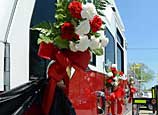
Cultural cachet
The Exception de Mixmind shop at Shanghai Xintiandi also highlights books. The shop's exterior wall is designed as a bookshelf displaying imported books in the arts and social sciences. The books are also displayed at the entrance, while garments and accessories are displayed on racks and shelves at the rear, surrounding books.
"When I saw the fa?ade, I thought it was a bookstore," says Leona Yan, a 32-year-old financial analyst who works nearby. "That's why I stopped and went inside. It was amazing to see a bookstore in a high-end complex like this."
She added that the books gave plus points to the shop's image. "I can see the books are carefully selected and it shows great taste of the owner (or whoever selected the books). That immediately sets this shop apart from other clothing brands for me. It's more cultural."
This demand for the cultural cachet has increased greatly, especially in wealthy areas.
But the statistics on readership in China are not encouraging.
Statistics from the Chinese Academy of Press and Publication released last week show a 1-percent increase in reading among citizens aged between 18 and 70 in 2012 - to 54.9 percent. On average, Chinese read less than five books in a year. The rate hit bottom at less than 50 percent in 2007, and then started climbing in 2007.
The academy's director Hao Zhensheng mainly attributed the increase to an increasing demand for culture that, he said, comes naturally with economic development. He cited the example of Jiangsu Province, which ranks high for both economic achievement and book consumption.

















 Local villagers climb mountains to get relief supplies
Local villagers climb mountains to get relief supplies


![]()
